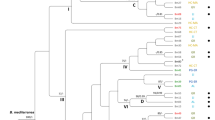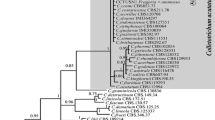Abstract
Biscogniauxia mediterranea is one of the most frequent fungal pathogens involved in cork oak decline in the Mediterranean Basin, causing charcoal canker. In Portugal, this disease is widespread on adult declining trees but nowadays it increasingly affects young trees and exhibits atypical symptoms, leading to the hypothesis that some change in the fungus may have occurred. In order to evaluate the genetic diversity and phylogenetic relationship of B. mediterranea associated with cork oak, 102 isolates were obtained from young and adult trees of Quercus suber and other hosts species with different disease expression, from several Mediterranean countries. The collection of isolates was analyzed by individual and multigene phylogenies using Maximum-Likelihood approach based on nucleotide sequences of the internal transcribed spacers of ribosomal DNA, translation elongation factor 1-α and β-tubulin genes, and by microsatellite-primed PCR profiles. Sequence analyses separated the Mediterranean isolates from those from other regions, while MSP-PCR analysis revealed relevant but unstructured diversity among the Mediterranean isolates under study, making this a monophyletic but diverse population. Considering the adaptive capacity of the fungus in the Mediterranean-climate ecosystems and the present climatic change scenario, all conditions are gathered to favor aggravation of the disease in cork oak stands.



Similar content being viewed by others
References
Brown, J. K. M., & Hovmaller, M. S. (2002). Aerial Dispersal of Pathogens on the Global and Continental Scales and Its Impact on Plant Disease. Science, 297, 537–541.
Burdon, J. J., & Silk, J. (1997). Sources and Patterns of Diversity in Plant-Pathogenic Fungi. Phytopathology, 87(7), 664–669.
Câmara, M. S. (1930). Contributions ad Mycoflorum Lusitaniae. Centuriae VIII et IX. Anais Instituto Superior de Agronomia, 3, 84.
Carbone, I., & Kohn, L. M. (1999). A method for designing primer sets for speciation studies in filamentous ascomycetes. Mycologia, 91(3), 553–556.
Cohen, S. D. (2005). A protocol for direct sequencing of multiple gene specific PCR products from Discula umbrinella, a fungal endophyte, utilizing bufferless precast electrophoresis. Journal of Microbiological Methods, 61(1), 131–135.
Collado, J., Platas, G., & Peláez, F. (2001). Identification of an endophytic Nodulisporium sp. from Quercus ilex in central Spain as the anamorph of Biscogniauxia mediterranea by rDNA sequence analysis and effect of different ecological factors on distribution of the fungus. Mycologia, 93(5), 875–886.
Cowling, R. M., Rundel, P. W., Lamont, B. B., Arroyo, M. K., & Arianoutsou, M. (1996). Plant diversity in mediterranean climate regions. Trends in Ecology & Evolution, 11(9), 362–366.
Diogo, E. L. F., Santos, J. M., & Philips, A. J. L. (2010). Phylogeny, morphology and pathogenicity of Diaporthe and Phomopsis species on almond in Portugal. Fungal Diversity, 44(1), 107–115.
Erwin, D. H. (2009). Climate as a Driver of Evolutionary Change. Current Biology, 19(14), R575–R583.
Glass, N. L., & Donaldson, G. C. (1995). Development of Primer Sets Designed for Use with the PCR To Amplify Conserved Genes from Filamentous Ascomycetes. Applied and Environmental Microbiology, 61(4), 1323–1330.
Henriques, J., Inácio, M. L., Lima, A., & Sousa, E. (2012). New outbreaks of charcoal canker on young cork oak trees in Portugal. IOBC/wprs Bulletin, 76, 85–88.
Henriques, J., Barrento, M. J., Bonifácio, L., Gomes, A. A., Lima, A., & Sousa, E. (2014a). Factors affecting the dispersion of Biscogniauxia mediterranea in Portuguese cork oak stands. Silva Lusitana, 22(1), 83–97.
Henriques, J., Nóbrega, F., Sousa, E., & Lima, A. (2014b). Diversity of Biscogniauxia mediterranea within single stromata on cork oak. Journal of Mycology, article ID 324349. doi:10.1155/2014/324349.
Hsieh, H., Ju, Y., & Rogers, J. D. (2005). Molecular phylogeny of Hypoxylon and closely related genera. Mycologia, 97(4), 844–865.
Inácio, M. L., Henriques, J., Guerra-Guimarães, L., Gil-Azinheira, H., Lima, A., & Sousa, E. (2011). Platypus cylindrus Fab. (Coleoptera: Platypodidae) transports Biscogniauxia mediterranea, agent of cork oak charcoal canker. Boletín de sanidad vegetal. Plagas, 37(2), 181–186.
Jiménez, J. J., Sánchez, M. E., & Trapero, A. (2005a). El chancro carbonoso de Quercus I: Distribución y caracterización del agente casual. Boletín de sanidad vegetal. Plagas, 31(4), 549–562.
Jiménez, J. J., Sánchez, M. E., & Trapero, A. (2005b). El chancro carbonoso de Quercus III: Dispersión de ascosporas del agente causal. Boletín de sanidad vegetal. Plagas, 31(4), 577–585.
La Porta, N., Capretti, P., Thomsen, I. M., Kasanen, R., Hietala, A. M., & Von Weissenberg, K. (2008). Forest pathogens with higher damage potential due to climate change in Europe. Canadian Journal of Plant Pathology, 30(2), 177–195.
Mazzaglia, A., Anselmi, N., Gasbarri, A., & Vannini, A. (2001a). Development of Polymerase Chain Reaction (PCR) assay for the specific detection of Biscogniauxia mediterranea living as an endophyte in oak tissues. Mycological Research, 105(8), 952–956.
Mazzaglia, A., Anselmi, N., Vicario, S., & Vannini, A. (2001b). Sequence analysis of the 5.8S and ITS regions in evaluating genetic relationships among some species of Hypoxylon and related genera. Mycological Research, 105(6), 670–675.
Papke, R. T., & Ward, D. M. (2004). The importance of physical isolation to microbial diversification. FEMS Microbiology Ecology, 48(3), 293–303.
Peakall, R., & Smouse, P. E. (2006). GENALEX 6: genetic analysis in Excel. Population genetic software for teaching and research. Molecular Ecology Notes, 6(1), 288–295.
Peakall, R., & Smouse, P. E. (2012). GenAlEx 6.5: genetic analysis in Excel. Population genetic software for teaching and research – an update. Bioinformatics, 28(19), 2537–2539.
Peláez, F., González, V., Platas, G., Sánchez-Ballesteros, J., & Rubio, V. (2008). Molecular phylogenetic studies within the Xylariaceae based on ribosomal DNA sequences. Fungal Diversity, 31, 111–134.
Santos, M. N. S. (2003). Contribuição para o conhecimento das relações Quercus suber- Biscogniauxia mediterranea (syn. Hypoxylon mediterraneum). Silva Lusitana, 11(1), 21–29.
Schiaffino, A., Francheschini, A., Maddau, L., & Serra, S. (2002). Molecular characterization of Biscogniauxia mediterranea (De Not.) strains isolated from the declining trees of Quercus suber L. in Sardania. IOBC/wprs Bulletin, 25(5), 37–40.
Sousa, E., Santos, M. N., Varela, M. C., & Henriques, J. (2007). Perda do vigor dos montados de sobro e azinho: análise da situação e perspetivas (Documento síntese). MADRP; DGRF; INRB, I.P.
Tamura, K., Stecher, G., Peterson, D., Filipski, A., & Kumar, S. (2013). MEGA6: Molecular Evolutionary Genetics Analysis version 6.0. Molecular Biology and Evolution, 30(12), 2725–2729.
Tang, A. M. C., Jeewon, R., & Hyde, K. D. (2009). A re-evaluation of the evolutionary relationships within the Xylariaceae based on ribosomal and protein-coding gene sequences. Fungal Diversity, 34, 155–153.
Thompson, J. D., Higgins, D. G., & Gibson, T. J. (1994). CLUSTAL W: improving the sensitivity of progressive multiple sequence alignment through sequence weighting, positions-specific gap penalties and weight matrix choice. Nucleic Acids Research, 22(22), 4673–4680.
Uddin, W., & Stevenson, K. L. (1997). Pathogenicity of a species of Phomopsis causing a shoot blight on peach in Georgia and evaluation of possible infection courts. Plant Disease, 81(9), 983–989.
Vannini, A., Mazzaglia, A., & Anselmi, N. (1999). Use of random amplified polymorphic DNA (RAPD) for detection of genetic variation and proof of the heterothallic mating system in Hypoxylon mediterraneum. European Journal of Plant Pathology, 29(3), 209–218.
White, T. J., Bruns, T., Lee, S., & Taylor, J. (1990). Amplification and direct sequencing of fungal ribosomal RNA genes for phylogenetics. In M. A. Innis, D. Gelfand, J. J. Sninsky, & T. J. White (Eds.), PCR Protocols: a guide to methods and applications (pp. 315–322). San Diego: Academic Press.
Acknowledgements
Authors are grateful to everyone who contributed to the sample collection and to Professor Manuel Mota for this manuscript revision. This research was partially supported by Fundação para a Ciência e a Tecnologia, Portugal (grant number SFRH/BD/46787/2008).
Author information
Authors and Affiliations
Corresponding author
Ethics declarations
Conflict of Interest
The authors declare that they have no conflict of interest.
Rights and permissions
About this article
Cite this article
Henriques, J., Nóbrega, F., Sousa, E. et al. Analysis of the genetic diversity and phylogenetic relationships of Biscogniauxia mediterranea isolates associated with cork oak. Phytoparasitica 44, 19–34 (2016). https://doi.org/10.1007/s12600-015-0503-0
Received:
Accepted:
Published:
Issue Date:
DOI: https://doi.org/10.1007/s12600-015-0503-0




